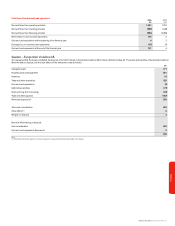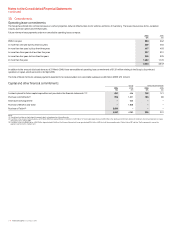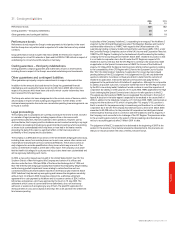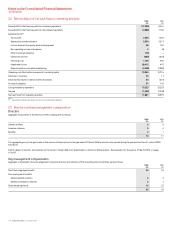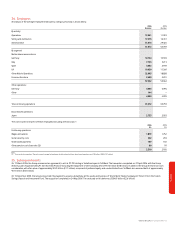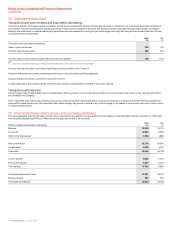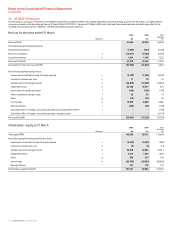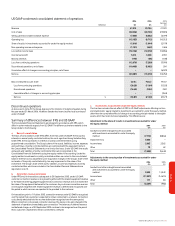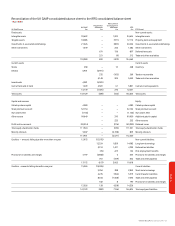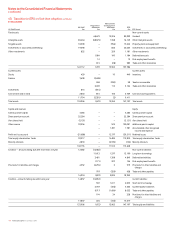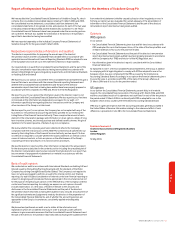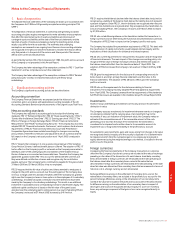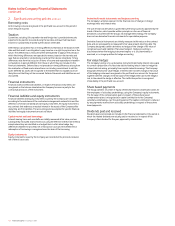Vodafone 2006 Annual Report Download - page 127
Download and view the complete annual report
Please find page 127 of the 2006 Vodafone annual report below. You can navigate through the pages in the report by either clicking on the pages listed below, or by using the keyword search tool below to find specific information within the annual report.
Vodafone Group Plc Annual Report 2006 125
Financials
During the year ended 31 March 2006, £9 million of foreign currency losses were
reclassified from other recognised income and expense and included in the
determination of US GAAP net loss as a result of the disposal of Vodafone Sweden.
During the year ended 31 March 2005, £63 million of foreign currency losses were
reclassified from other recognised income and expense and included in the
determination of US GAAP net loss as a result of the partial disposal of Vodafone Egypt.
Under IFRS, these gains amounted to £36 million for the year ended 31 March 2006.
h. Income taxes
The most significant component of the income tax adjustment is due to temporary
differences between the book basis and tax basis of intangible assets other than
goodwill acquired in business combinations prior to 29 September 2004, resulting in the
recognition of deferred tax liabilities under US GAAP. This line item also includes the tax
effects of the other pre-tax IFRS to US GAAP adjustments described above.
Under IFRS, the Group does not recognise a deferred tax liability on the outside basis
differences in its investment in associates to the extent that the Group controls the
timing of the reversal of the difference and it is probable the difference will not reverse in
the foreseeable future. Under US GAAP, the Group recognises deferred tax liabilities on
these differences.
i. Minority interests
Minority interests are reported as a component of total equity under IFRS and,
accordingly, profit for the period does not include an adjustment for profit for the period
attributable to minority interests. Under US GAAP, minority interests are reported outside
of shareholders’ equity and the minority interest in the income of consolidated
subsidiaries is an adjustment to US GAAP net income.
j. Changes in accounting principles
Post employment benefits
During the second half of the year ended 31 March 2005, the Group amended its policy
for accounting for actuarial gains and losses arising from its pension obligations effective
1 April 2004. Until 31 March 2004, the Group used a corridor approach under SFAS No.
87, “Employers’ Accounting for Pensions” in which actuarial gains and losses were
deferred and amortised over the expected remaining service period of the employees.
The Group now recognises these gains and losses through the income statement in the
period in which they arise as the new policy more faithfully represents the Group’s
financial position and more closely aligns the Group’s US GAAP policy to its IFRS policy
of immediate recognition of these items.
The cumulative effect on periods prior to adoption of £288 million has been shown, net
of tax of £93 million, as a cumulative effect of a change in accounting principle in the
reconciliation of net loss. The effect of the change in the year ended 31 March 2005 was
to increase loss from continuing operations by £55 million (or 0.08 pence per share).
Intangible assets
On 29 September 2004, the SEC Staff issued new guidance on the interpretation of SFAS
No. 142 in relation to the valuation of intangible assets in business combinations and
impairment testing. This guidance has been codified as EITF Topic D-108. Historically,
the Group assigned to mobile licences the residual purchase price in business
combinations in excess of the fair values of all assets and liabilities acquired other than
mobile licences and goodwill. This approach was on the basis that mobile licences were
indistinguishable from goodwill. The new SEC guidance requires the Group to distinguish
between mobile licences and goodwill. However, the new guidance does not permit the
amount historically reported as mobile licences to be subsequently reallocated between
mobile licences and goodwill.
The new guidance will affect the allocation of the purchase price in future business
combinations involving entities with mobile licences. The Group has applied the
guidance relating to the allocation of purchase price to all business combinations
consummated subsequent to 29 September 2004. This has resulted in values being
assigned to licences using a direct valuation method, with any remaining residual
purchase price allocated to goodwill.
In impairment testing of mobile licences associated with the Verizon Wireless equity
method investment accounted for under SFAS No. 142, the Group has used a similar
residual approach to determine the fair value of the licences when testing the asset for
recoverability. In their announcement, the SEC Staff stated that the residual method of
accounting for intangible assets should no longer be used and that companies should
perform an impairment test using a direct method on all assets which were previously
tested using a residual method. The Group’s licences in other businesses are not tested
for recoverability using a residual method and are, therefore, not affected by the new
guidance.
The Group completed its transitional impairment test of Verizon Wireless’ mobile
licences as of 1 January 2005. This resulted in a pre-tax charge of £11,416 million. This
impairment loss is included, net of the related tax of £5,239 million, in the cumulative
effect of change in accounting principle in the reconciliation of net loss. The tax effect
comprises the release of £1,220 million representing the Group’s share of Verizon
Wireless’ deferred tax liabilities and £4,019 million deferred tax liabilities representing
taxes recognised by the Group on its investment in Verizon Wireless. Fair value was
determined as the present value of estimated future net cash flows allocable to the
mobile licences. Verizon Wireless is included in the segment “Mobile
telecommunications – US”.
Share-based payments
The Group adopted SFAS No. 123 (Revised 2004), “Share-based Payment”, and related
FASB staff positions on 1 October 2005. SFAS No. 123 (Revised 2004) eliminates the
option to account for share-based payments to employees using the intrinsic value
method and requires share-based payments to be recorded using the fair value method.
Under the fair value method, the compensation cost for employees and directors is
determined at the date awards are granted and recognised over the service period.
Concurrent with the adoption of SFAS No. 123 (Revised 2004), the Group adopted Staff
Accounting Bulletin (SAB) 107. SAB 107 summarises the views of the SEC Staff regarding
the interaction between SFAS No. 123 (Revised 2004) and certain SEC rules and
regulations and provides the staff’s views regarding the valuation of share-based
payment arrangements for public companies.
The Group has adopted SFAS No. 123 (Revised 2004) using the modified retrospective
method. Under this method, the Group has adjusted the financial statements for the
periods between 1 April 1995 and 30 September 2005 to give effect to the fair value
method of accounting for awards granted, modified or settled during those periods on a
basis consistent with the pro forma amounts disclosed under the requirements of the
original SFAS No. 123, “Accounting for Stock-Based Compensation”. The provisions of
SFAS No. 123 (Revised 2004) will be applied to all awards granted, modified, or settled
after 1 October 2005. The effect of applying the original provisions of SFAS No. 123
under the modified retrospective method of adoption on the year ended 31 March 2005
was to decrease loss before income taxes, loss from continuing operations and net loss
by £66 million, £30 million and £30 million respectively (six months ended 30
September 2005: increases of £4 million, £8 million and £8 million respectively). The
adjustment also had the effect of decreasing both basic and diluted loss per share from
continuing operations and net loss by 0.05 pence (six months ended 30 September
2005: increase 0.01 pence). The adoption of SFAS No. 123 (Revised 2004) increased
shareholders’ equity at 1 April 2004 by £112 million.
k. Loss per share
The share options and shares described in note 20 were excluded from the calculation
of diluted loss per share as the effect of their inclusion in the calculation would be
antidilutive due to the Group recognising a loss in all periods presented.
39. New accounting standards
The Group has not adopted the following standards, which have been issued by the IASB
or the International Financial Reporting Interpretations Committee (“IFRIC”). The Group
does not currently believe the adoption of these standards will have a material impact
on the consolidated results or financial position of the Group.
•IAS Amendment, “Amendment to IAS 1, “Presentation of Financial Statements” –
Capital Disclosures” (effective for annual periods beginning after 1 January 2007, with
earlier application encouraged).
•IFRIC 4, “Determining whether an Arrangements contains a Lease” (effective from 1
April 2006).
•IFRIC 5, “Rights to Interests arising from Decommissioning, Restoration and
Environmental Rehabilitation Funds” (effective from 1 April 2006).
•IFRIC 6, “Liabilities arising from Participating in a Specific Market – Waste Electrical
and Electronic Equipment” (effective from 1 April 2006).
•IFRIC 7, “Applying the Restatement Approach under IAS 29, “Financial Reporting in
Hyperinflationary Economies”” (effective from 1 April 2006).
•IFRIC 8, “Scope of IFRS 2” (effective for annual periods beginning on or after 1 May
2006, with early application encouraged). This interpretation has not yet been
adopted for use in the EU.
•IFRIC 9, “Reassessment of Embedded Derivatives” (effective for annual periods
beginning on or after 1 June 2006, with early application encouraged). This
interpretation has not yet been adopted for use in the EU.


